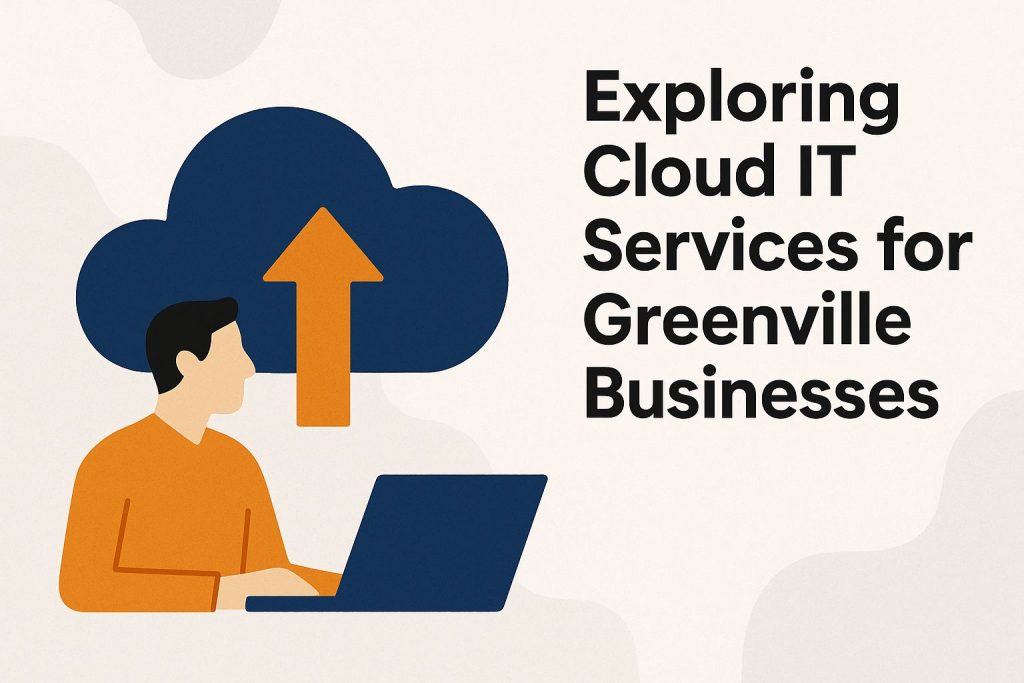Cloud Migration Mistakes Greenville Businesses Should Avoid

Cloud migration is important for businesses. It helps improve efficiency and scalability. The journey to the cloud has many potential problems. Many organizations face common traps. These include poor planning, ignoring security, and misjudging resource needs. These can lead to major setbacks. This article looks at these pitfalls. It also offers best practices for a smooth migration.
What is Cloud Migration and Why is it Important?

Cloud migration is moving data, applications, and IT resources from local systems to the cloud. This can be public, private, or hybrid.
Cloud migration improves operational efficiency. It ensures data integrity, reduces downtime, and optimizes costs. This contributes to better business continuity and ROI.
Common Mistakes in Cloud Migration
Despite the advantages of cloud migration, many organizations face serious pitfalls. These include vendor lock-in and integration challenges.
Common mistakes in cloud migration are:
- Insufficient planning and assessment
- Neglecting security risks, compliance issues, and incident response planning
- Underestimating the resources required for a successful transition
These mistakes can cause data loss, increase downtime, and raise costs. They can affect project success and long-term goals.
Lack of Proper Planning and Assessment
A critical mistake in cloud migration is poor planning and assessment. This can lead to project challenges and wasted resources. Without a clear migration strategy, businesses face problems like poor resource allocation and missed contingencies. This hinders cloud adoption.
A well-structured migration plan prioritizes the identification of existing workloads and resources while ensuring that every potential risk is thoroughly assessed. By implementing best practices-such as conducting a comprehensive inventory of current systems and forecasting future needs-organizations can develop a roadmap that minimizes disruptions.
Involving stakeholders from different departments is essential. This helps gather insights and fosters collaboration in decision-making.
This meticulous approach to resource allocation and contingency planning significantly reduces the likelihood of encountering implementation challenges, enabling businesses to transition smoothly into the cloud while maximizing their operational efficiency.
Not Considering Security and Compliance
Ignoring cloud security and compliance can expose organizations to risks and legal issues.
Many businesses overlook security risks in data management and regulatory requirements when choosing a cloud provider.
Organizations must integrate security measures and compliance into their cloud migration strategies. This is necessary, not just a precaution. By thoroughly understanding the regulatory landscape, companies can make informed decisions that significantly impact vendor selection, ensuring that their cloud providers possess the appropriate certifications and practices.
This approach includes regular audits, data encryption, and adherence to privacy laws, fostering a secure environment for data.
These steps protect sensitive information and build trust with clients and stakeholders. For a deeper dive into effective cybersecurity practices, explore our related callout: IT Security Services Greenville. They show a strong commitment to safeguarding their interests.
Underestimating the Time and Resources Needed

Underestimating the time and resources for a successful cloud migration is a common mistake. It can derail projects and frustrate stakeholders.
Organizations often overlook complexities in implementation. This includes addressing skills gaps, establishing realistic timelines, and ensuring budgets cover unexpected costs.
This oversight can cause prolonged downtimes, unexpected costs, and insufficient technical support during migrations.
By incorporating strategic planning, training for team members, aligning budgets, and setting achievable milestones, companies can reduce risks in cloud migrations. Ultimately, a well-considered approach fosters smoother transitions and more effective utilization of cloud resources.
Best Practices for Successful Cloud Migration
Organizations must implement best practices for successful cloud migration. This maximizes benefits while minimizing risks.
These best practices include:
- Developing a comprehensive migration plan,
- Ensuring security and compliance throughout the process,
- Effectively managing time and resource allocation to achieve optimal outcomes.
By focusing on cloud architecture and adopting a strategic approach, businesses can adeptly navigate the complexities involved in their transition to the cloud. For those seeking further guidance, explore how selecting the right managed IT provider can support successful cloud migration.
Creating a Solid Migration Strategy and Plan
A solid migration strategy and plan are essential for successful cloud migration. It serves as a roadmap guiding organizations through each stage.
Organizations should incorporate best project management practices for optimal results. This includes establishing clear roles and responsibilities, setting achievable milestones, and utilizing collaborative tools to enhance communication. Prioritizing risk mitigation strategies is also critical, as it allows for the identification and analysis of potential challenges before they occur.
Performance tracking becomes essential during this transition, enabling the organization to monitor key metrics that align with their migration objectives, such as system uptime and resource utilization. By taking these actionable steps, organizations can minimize disruptions and ensure a smoother transition to the cloud, ultimately leading to greater operational efficiency and scalability.
Ensuring Security and Compliance
Robust security and compliance measures are critical during cloud migration. Organizations must adhere to regulations to protect sensitive data and maintain trust. This involves comprehensive evaluations of potential cloud providers, understanding their security protocols, and implementing necessary audit trails to monitor compliance throughout the migration process.
To achieve these objectives, it is essential for organizations to conduct a thorough risk assessment to identify vulnerabilities within their current systems. Engaging in discussions with prospective cloud vendors can provide insight into their commitment to compliance standards, such as GDPR or HIPAA.
Organizations should prioritize the implementation of encryption technologies, regular security assessments, and continuous monitoring to safeguard their data.
Selecting a cloud provider that offers transparent compliance reporting can further enhance trust and accountability, facilitating a more secure and compliant migration. Ultimately, a strategic approach that emphasizes both security measures and thorough oversight will contribute to a successful transition.
Properly Managing Time and Resources

Proper management of time and resources is crucial for organizations. This includes managing technical debt and network latency. Mismanagement can lead to implementation challenges and project delays. By establishing clear project timelines, effective resource allocation, and implementing automation, businesses can remain on track and efficiently achieve their migration goals.
Prioritizing tasks helps organizations find bottlenecks early. A detailed project roadmap is crucial. It is also essential to consider the skill sets of team members when assigning responsibilities, ensuring that each aspect of the migration is managed by individuals with the necessary expertise.
Regular evaluations keep the project on track, allowing teams to adapt strategies swiftly when necessary. These best practices not only enhance operational efficiency but also mitigate the risks associated with transitioning to a cloud-based infrastructure.
Frequently Asked Questions
What are some common cloud migration mistakes that businesses in Greenville should avoid?
Common mistakes include not assessing current infrastructure, overlooking cloud scalability, underestimating cost estimation and management, and failing to create a detailed migration plan considering a comprehensive cloud strategy encompassing public cloud, private cloud, or hybrid cloud options.
Why is it important for businesses in Greenville to have a detailed migration plan?
A detailed migration plan helps Greenville businesses identify roadblocks, allocate IT resources effectively, and minimize service-level agreements and disruptions to operations, ensuring optimal cloud implementation and data transfer processes.
What are the risks of not properly assessing the current infrastructure before migrating to the cloud?
Not properly assessing the current infrastructure can lead to compatibility issues, data loss, and higher costs in the long run. This may cause failed migrations and wasted time.
How can businesses in Greenville avoid underestimating the cost and effort involved in a cloud migration?
Businesses should conduct thorough research and consult with experts to get a clear understanding of the costs and efforts involved in a cloud migration. Consider all factors: data transfer, training, and downtime.
What are some steps businesses in Greenville can take to ensure a successful cloud migration?
Steps Greenville businesses can take include assessing infrastructure and creating a migration roadmap, pilot testing, and providing proper employee training programs and support during and after the migration, ensuring efficient cloud optimization and cloud-native applications deployment.
How can failing to properly train employees on the new cloud system affect a business in Greenville?
Failing to properly train employees can lead to confusion, errors, and even security breaches. This can harm productivity and profits. It is important to invest in proper training to ensure a smooth transition to the cloud.




